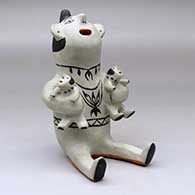
Click or tap to see a larger version
Unknown, Cochiti, A sitting grandfather storyteller figure holding two children
Cochiti
$ 450
rbco4j162
A sitting grandfather storyteller figure holding two children
5.25 in L by 4 in W by 6.5 in H
Condition: Very good with leg restoration
Tell me more! Buy this piece!
(505) 986-1234 - www.andreafisherpottery.com - All Rights Reserved
Cochiti Pueblo
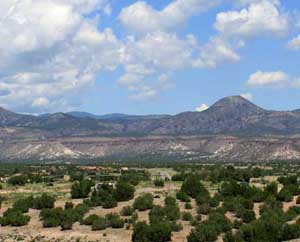
View west across Cochiti Pueblo
Cochiti Pueblo lies fifteen miles south of Santa Fe along the west bank of the Rio Grande. Frijoles Canyon in what is now Bandelier National Monument is the site of the pueblo's most recent ancestral home. The Eastern Keresans may have relocated to the Bandelier area from the Four Corners region around 1300.
Cochiti legend says that Clay Old Woman and Clay Old Man came to visit the Cochitis. While all the people watched, Clay Old Woman shaped a pot. Clay Old Man danced too close and kicked the pot. He rolled the clay from the broken pot into a ball, gave a piece to all the women in the village and told them never to forget to make pottery.

At Bandelier National Monument
In prehistoric times, human effigy pots, animals, duck canteens and bird shaped pitchers with beaks as spouts were common productions of the Cochiti potters. Many of these were condemned as idols and destroyed by the Franciscan priests. That problem stopped when the Spanish left in 1820 but the fantastic array of figurines created by Cochiti potters was essentially dormant until the railroad arrived. Then Cochiti potters were among the first to enter the tourist market and they produced many whimsical figures into the early 1900s. Then production followed the market into more conventional shapes.
Legend has it that a Ringling Brothers Circus train broke down near Cochiti Pueblo in the 1920s. Supposedly, the tribe's contact with the ringmaster, trapeze artists, opera singers, sideshow "freaks" and exotic animals paved the way for a variety of new figural subjects. However, shortly after the railroad passed through, a delegation of Cochiti men got on the train and traveled to Washington DC. There they were introduced to the President, spoke to Congress, and were taken on a tour of the "highlights" of American civilization in Washington and in New York City, incuding the Metropolitan Opera, the Bronx Zoo and a performance of the Ringling Brothers Circus. As none of the men could read or write, nor draw, what they brought back to Cochiti was what they remembered of things they had never seen before. The stories they told must have been wild. An astute observer will find angels, nativities, cowboys, tourist caricatures, snakes, dinosaurs, turtles, goats, two-headed opera singers, clowns, tattooed strongmen, Moorish nuns and even mermaids in the Cochiti pottery pantheon, many produced only since the early 1960s and based on characters described in Cochiti's oral history.
A few modern potters make traditional styled pots with black and red flowers, animals, clouds, lightning and geometric designs but most Cochiti pottery artists now create figurines. Most notable is the storyteller, a grandfather or grandmother figure with "babies" perched on it. Helen Cordero is credited with creating the first storyteller in 1964 to honor her grandfather. The storyteller style was quickly picked up by other pueblos and each modified the form to match their local situation (ie: clay colors and tribal and religious traditions). In some pueblos, storytellers are also now made as drummers and as a large variety of animals.
Today, Cochiti potters face the challenge of acquiring the clay for the white slip. Construction of Cochiti Dam in the 1960s destroyed their primary source of their trademark white slip and gray clay. Now the white slip comes from one dwindling source at Santo Domingo, Cochiti Pueblo's neighbor to the south.
Most outsiders who visit Cochiti Pueblo these days do so on the way to or from either the recreation area on Cochiti Lake or Kasha-Katuwe Tent Rocks National Monument.
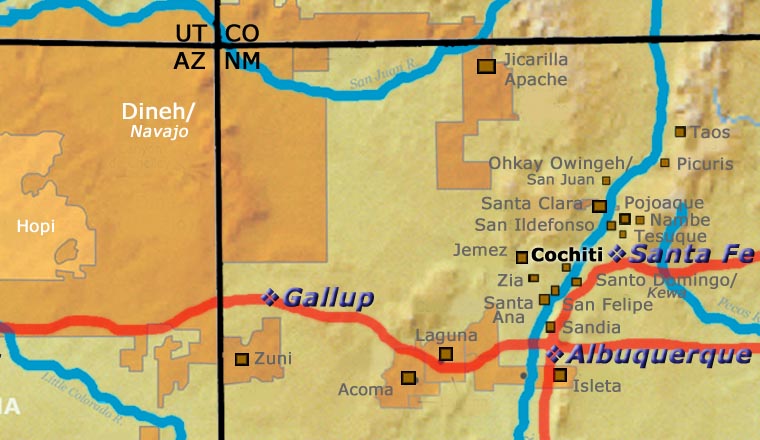
Storytellers
Pueblos: Cochiti, Jemez, Acoma, Isleta, Santa Clara
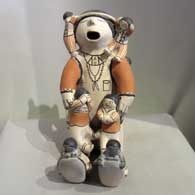
Helen Cordero
Cochiti Pueblo
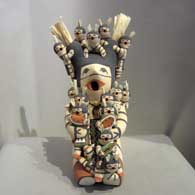
Judy Toya
Jemez Pueblo
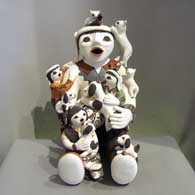
Marilyn Ray
Acoma Pueblo
Clay figurines have been present in the Pueblo pottery tradition for at least the last thousand years. However, between 1540 and 1820 CE, figures and effigies were denounced as "works of the devil" by the Spanish priests. Before and after that time, the art of making figurative pottery flourished, especially at Cochiti Pueblo.
The "storyteller" is an important role in the tribe as the Native American people did not have a method for writing down anything. The closest thing they had to a written language were the designs they used to decorate pottery, textiles, baskets and stone. The storyteller's role was to preserve, retell and pass down the oral history of their people. In most tribes that role was fulfilled by men.
The first real storyteller figure was created in 1964 by Cochiti Pueblo potter Helen Cordero. She made it in memory of her grandfather, Santiago Quintana, and the stories he sang to her and other children in their native Keres when she was young. Helen's creation struck a chord throughout all the pueblos as the storyteller is a figure central to all their societies. Most tribes also have the figure of the Singing Maiden in their pantheon and in many cases, the mix of Singing Maiden and Storyteller has blurred some lines in the pottery world. Today, as many as three hundred potters in thirteen pueblos have created storytellers, and their storytellers are not only men and women but also Santa's, mudheads, koshares, bears, owls and other animals, sometimes encumbered with children numbering more than one hundred! Each potter has also customized their storyteller figures to more closely reflect the forms, dress and decorations of their own tribes, often even of their own clans.
Copyright © 1998-2025 by



